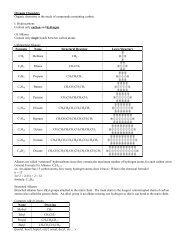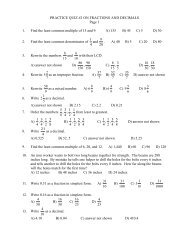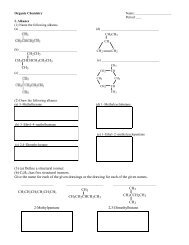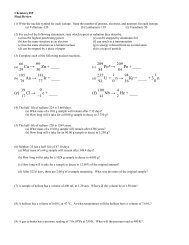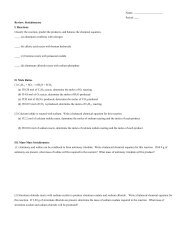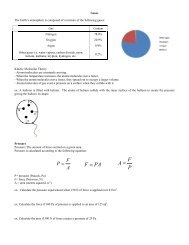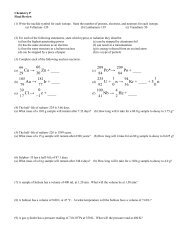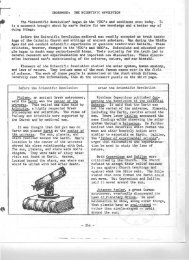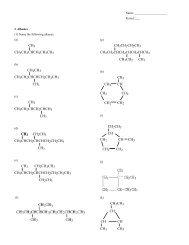- Then there was the movement towards more direct participation in gov’t, which, it was hoped, wouldcontrol corruption. Progressives wanted: the initiative [propose laws], the referendum [vote on laws], andthe recall [get rid of offending officials].- One thing to remember – not everyone in the PE was actually a Progressive. Plenty of people opposedthem: Socialists from the left, and business leaders and anti-gov’t interference people from the right.Progressives were basically in the center.*Governmental and Legislative Reform*- With the big economic crises of the late 1800s, <strong>Am</strong>erican resistance to gov’t interference in daily life beganto diminish. Progressives, especially, saw the gov’t as a tool that would ensure social justice and act againstinefficiency and exploitation. But first, they felt, they had to eliminate corruption.- Before the Progressive Era, reformers had tried to wipe out boss politics in the cities – this had been onlypartially successful – but after 1900 it worked out as city manager and <strong>com</strong>mission forms of city gov’t wereinstalled. But the cities were not enough…most Progressives wanted state and nat’l gov’t reform as well.- Naturally, each region had its own pet peeves. One thing that was <strong>com</strong>mon, though, was a belief in strong,fair executives, esp. governors like Wisconsin’s Robert “Battling Bob” La Follette, who installed a majorreform program w/direct primaries, fairer taxes, RRD regulation, and <strong>com</strong>missions staffed by experts.- Anyhow, the crusade against corruption worked to some extent throughout the country [e/t in the South,many Progressives were still racists] – by 1916 all but 3 states had the initiative, referendum and recall; andin 1913 the Seventeenth <strong>Am</strong>endment was passed, which provided for direct election of Senators.Nevertheless, there were still many cases were bosses stayed just b/c of their superior organization.- When it came to labor regulation, however, legislation was much more effective b/c both reformers andbosses supported it. States passed laws protecting public health and safety (police), supporting factoryinspection, requiring accident <strong>com</strong>pensation, and banning child labor.- Then there was the moral angle, which was far more controversial…some of the major issues includeddrinking habits [Anti-Saloon League (1893)], which resulted in the Eighteenth <strong>Am</strong>endment outlawing thesale of liquor, and prostitution – “white slavery” – a threat that was really more imagined than real, but stillmanaged to get a whole lot of attention and the passage of the Mann Act (1910), which prohibitedtransportation of a woman for immoral purposes.- Overall, the reformers’ efforts reflect their ideology that environment, not human nature, creates sin…i.e.that humans can achieve perfection in the right setting.*New Philosophies in the Progressive Era*- Changes in society prompted a multitude of new ideas during the Progressive Era, including: Education – For the first time, educators were faced w/masses of children going to school fulltime [b/c of the growth of cities]. In response, philosopher John Dewey [The School andSociety (1899), Democracy and Education (1916)] decided that personal development shouldbe the focus of education, and that all teaching had to relate directly to experience, so that kids“discover knowledge for themselves.” Yeah, now we know who to blame for all the stupid stuffwe did in elementary school! But this ended up in colleges too, which soon began to expandtheir curriculums – still, women/blacks were mostly left out of educational opportunities. Law – A new legal philosophy, led by Roscoe Pound, held that social reality should influencelegal thinking – i.e. the law should reflect society’s needs and work from experience [gatheringscientific data], not be this abstract, inflexible thing. Of course, this methodology metopposition in the old laissez-faire judges, who struck down public safety regulations in caseslike Lochner v. NY (1905). But some were also upheld – ex. Holden v. Hardy (1898). Anotherbig question was: how can general welfare benefit w/o oppressing minorities? Social Science – Similar to changes in law, new scholars began to argue that economicrelationships depended on social conditions [as opposed to being timeless]. Progressivehistorians [Frederick Jackson Turner, Charles A. Beard] also emphasized the flexibility ofthe Constitution – it has to serve each age in its own way. Public Health – New organizations, like the National Consumers League joined scientists to<strong>com</strong>bat workplace hazards, help female workers, and urge for food safety regulations. Eugenics – B/c of Darwin, some people [Francis Galton] came up w/the idea that society hadan obligation to prevent “defective” people from reproducing. This resulted in laws in somestates allowing sterilization of criminals and the mentally ill. This thinking received a boost inThe Passing of the Great Race (1916) by Madison Grant, which held that immigrants werethreatening the superior Nordic race.50
- MOST IMPORTANTLY, though, was the Social Gospel – Underlying all Progressive actions was the ideathat, instead of Social Darwinism, people have an obligation to help improve society. This idea was rooted inreligion, and in the previous evangelical reform movement philosophies.*Challenges to Racial/Sexual Discrimination*- Most minorities were ignored by Progressives, but they found their own leaders willing to challengeinequality. By 1900, in the South, blacks faced constant segregation via Jim Crow laws [caused by Plessy v.Ferguson], discrimination, and violence. This held true, to a lesser degree, even when they moved North.- There were two main leaders/responses to the problem faced by blacks: Booker T. Washington [rural] – Through “Self-Help” [hard work leading to economic success],Washington felt that blacks could eventually acquire social and political rights. For the timebeing, however, he felt that they should <strong>com</strong>promise with whites – though he did not feelblacks were inferior, he still endorsed a separate-but-equal policy. But his views, as presentedin the Atlanta Exposition (1895), encountered opposition from more radical elements.WEB Du Bois [urban] – In response to Washington, DB felt that blacks should not have totolerate white domination and should immediately fight for their social and political rights. DBmet with supporters at the Niagara Conference, and, in 1909, he joined w/white liberals toform the NAACP, which advocated an end to discrimination.- <strong>Am</strong>erican Indians also attempted to form the Society of <strong>Am</strong>erican Indians (SAI), but it didn’t work out as agoverning body b/c racial pride gave way to tribal pride, not unity.- As for “The Woman Movement,” the Progressive Era heralded an important shift in ideas from the thoughtthat women were special and belonged in other areas of society [so that they could spread their uniquetalents] to the newfangled *shocking* concept that women needed economic/sexual equality andindependence. The latter idea, which arose around 1910, was known as feminism.- With feminism came the idea of “sex rights” and birth control as proposed by leader Margaret Sanger, whoformed the <strong>Am</strong>erican Birth Control League and managed to make the issue part of public debate.- Then, of course, there was suffrage…led by Harriot Blatch, feminists argued that women needed the voteas political leverage to get better working conditions [all women worked, she argued, whether paid/unpaid].- Anyhow, the suffragists achieved successes through letter-writing, NAWSA articles, marches of theNational Woman’s Party [Alice Paul] and, most of all, women’s roles in WWI. As a result, the nat’l suffrageamendment was finally passed in 1920. Nevertheless, women remained subordinate to men socially andeconomically for some time.*Theodore “Teddy” Roosevelt and the Revival of the Presidency*- After the assassination of McKinley in September 1901, young Theodore Roosevelt was sent into theWhite House. Roosevelt supported regulatory legislation, obsessed over “manliness,” and was a brilliantrhetorician and publicity monger.- Issues addressed by TR: Trust-Busting – TR agreed w/Progressives that the new era needed a bigger, stronger nat’lgov’t that would act as an umpire in the big business game, deciding which business wereokay and which weren’t. And e/t TR wasn’t as big a “trust-buster” as he claimed and onlyattacked “bad” trusts [he even instructed his Bureau of Corporations to assist in some formsof expansion], he did use the Justice Dept. to prosecute trusts that were exploiting the public,like the Northern Securities (1904) case. Regulatory Legislation – TR also supported regulatory legislation, like the Hepburn Act(1906), which gave the ICC more authority to set RRD rates. Also, TR investigated the meatindustry [Sinclair’s The Jungle] and subsequently supported the Meat Inspection Act (1906)and the Food and Drug Act (1906). In both areas, however, TR <strong>com</strong>promised rather than risknot gaining anything. Labor – W/regard to labor, TR generally favored investigation and arbitration. In the UnitedMine Workers Strike (1902), he raised public opinion in favor of the miners and threatened touse troops to reopen the mines to force arbitration by a <strong>com</strong>mission, which eventually raisedwages, reduced hours and required dealing w/grievances [but didn’t require recognition of theunion]. W/labor, TR felt only some organizations were legitimate, and wished to keep control.Conservation – TR made huge changes in federal policy towards resources by keeping land inthe public domain and supporting the Newlands Reclamation Act (1902), which controlledsales of irrigated land in the West. He increased nat’l forests and created the US ForestService w/Gifford Pinchot, who advocated scientific management to prevent overuse.- Then came the Panic of 1907, which forced TR into a <strong>com</strong>promise w/JP Morgan – in return for convincingfinanciers to stop dropping stocks, TR approved a deal for US steal to get a smaller <strong>com</strong>pany. But, during51
- Page 3 and 4: Congregationalists (Puritans) - The
- Page 5 and 6: - So the Restoration Colonies, form
- Page 7 and 8: - So in England, where they were lo
- Page 9 and 10: *Colonial Politics 1700-1750: Relat
- Page 11 and 12: - Another ideology that was beginni
- Page 13 and 14: - The Quebec Acts were passed aroun
- Page 15 and 16: - So, by 1782, what had seemed to b
- Page 17 and 18: on the economic side, since the gov
- Page 19 and 20: - Anyway, Congress had several ques
- Page 21 and 22: - Adams was still in the early Wash
- Page 23 and 24: *Political Factionalism and Jeffers
- Page 25 and 26: - Samuel Slater set up the first te
- Page 27 and 28: - Court rulings extended the powers
- Page 29 and 30: Revival, Reform and Politics during
- Page 31 and 32: - Anyhow, during his administration
- Page 33 and 34: TEXAS (Southerners) - Texas had bee
- Page 35 and 36: - Anyhow, Pierce’s total support
- Page 37 and 38: They had a smaller everything: smal
- Page 39 and 40: - The two Northern victories at the
- Page 41 and 42: - The result was the Fourteenth Ame
- Page 43 and 44: The Slaughter-House Cases (1873) -
- Page 45 and 46: in the arrest of 8 immigrant radica
- Page 47 and 48: case (1897 - ICC can’t set rates)
- Page 49: - The Populists prepared to run aga
- Page 53 and 54: - So, what led the US to undertake
- Page 55 and 56: - The rebellion, led by Emilio Agui
- Page 57 and 58: - Still, Americans managed to turn
- Page 59 and 60: - So - the point of this episode? B
- Page 62 and 63: *Hoover’s Response*- Poor Herbert
- Page 64 and 65: - In FDR’s second term, however,
- Page 66 and 67: Dominican Republic - When we left i
- Page 68 and 69: World War II (1941 - 1945)*The Cour
- Page 70 and 71: - So Truman started off again all c
- Page 72 and 73: - First of all, the 1950s were (for
- Page 74 and 75: peace w/Japan that ended occupation
- Page 76: - France wanted out, so at the Gene



